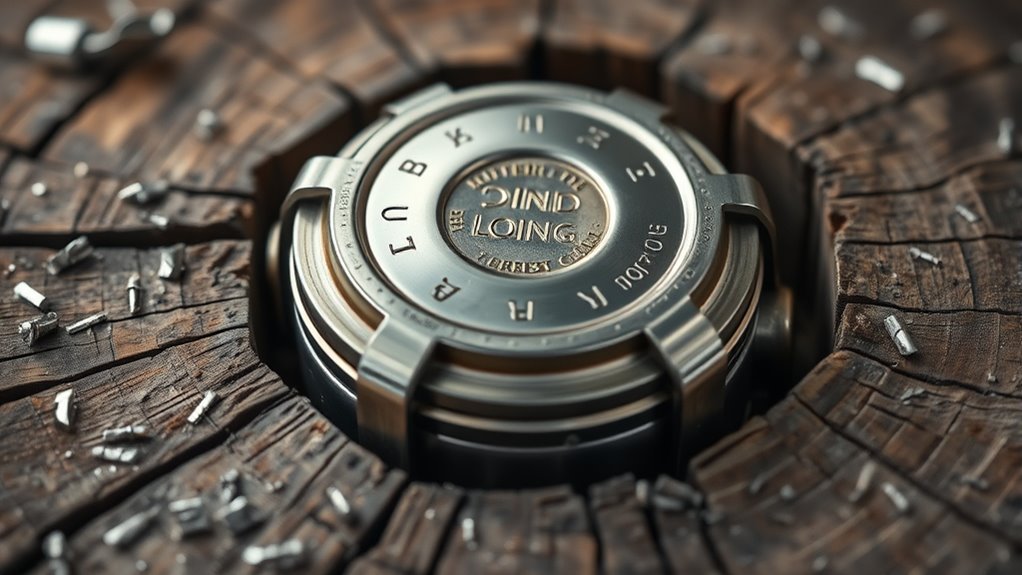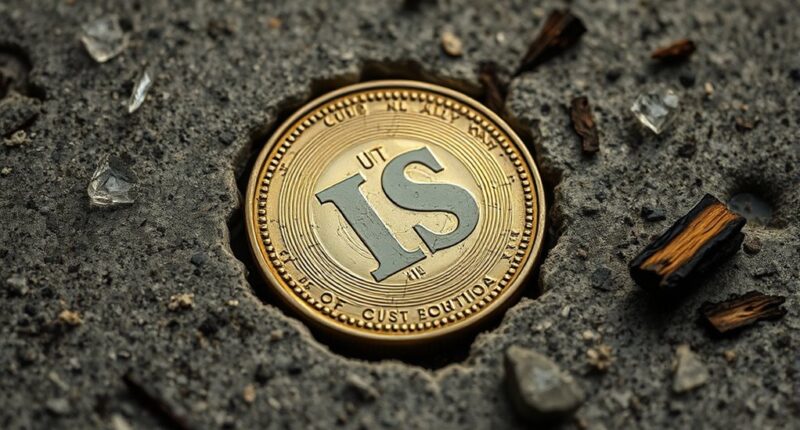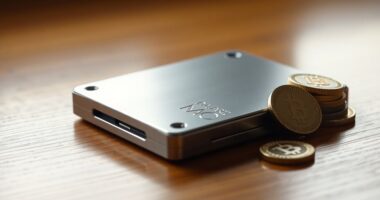To disaster-proof your coins, use a durable metal backup engraved with your seed phrase, resistant to fire, water, and age. Store it in a secure location away from potential hazards and avoid digital storage online to prevent hacking. Consider splitting the encrypted seed into shards stored across trusted trusted locations or individuals for added security. Combining physical with digital strategies creates a layered defense. Keep your backup safe and learn more about creating the ultimate safeguard for your assets.
Key Takeaways
- Use durable metal backups like stainless steel or titanium engraved with your seed phrase for maximum resistance.
- Store backups in secure, protected locations away from water, fire, and environmental hazards.
- Encrypt seed phrases before engraving or storing digitally to prevent theft if backups are compromised.
- Employ multiple backup methods (metal, paper, digital) and distribute copies across trusted, separate locations.
- Regularly test your recovery process to ensure backups are readable and functional in disaster scenarios.

Disasters can strike unexpectedly, putting your cryptocurrency holdings at risk if your backup methods aren’t resilient. Your seed phrase is the master key to your wallet, so safeguarding it against all threats is crucial. Relying solely on paper backups leaves you vulnerable to fire, water damage, mold, or simple aging. Even if stored in a fireproof safe, extreme heat or prolonged dampness can cause the paper to fail, risking permanent data loss. Furthermore, physical theft of your backup can compromise your entire wallet if it isn’t encrypted. Writing errors or faded ink over time may make the seed unreadable when you need it most, increasing the chance of losing access during recovery. Sharing the backup’s location with other valuables or in insecure places exposes it to targeted disasters or theft, further compromising your security.
Relying solely on paper backups risks loss from fire, water, mold, or aging—consider more durable, secure storage solutions.
To counter these vulnerabilities, metal backups offer a superior solution. Using stainless steel or titanium plates, you can engrave or stamp your seed phrase in a way that withstands fire, water, and other natural calamities. Metal backups are durable and designed for long-term survival; commercial options often feature modular, tool-free engraving, making DIY backups straightforward. For added security, you can encrypt your seed before engraving, ensuring that even if someone finds the backup, they can’t access your funds without the decryption key. Metal backups are also resistant to environmental wear, and their longevity exceeds that of paper or digital media. Many users also opt for professional engraving services to ensure precision and durability. Remember, a metal backup’s safety depends on how and where you store it. Secure storage is crucial because a sturdy backup in a vulnerable location defeats its purpose.
Digital backup options can supplement physical methods, providing redundancy and flexibility. Decentralized mesh networks can split your seed into encrypted shards stored across trusted devices or individuals, reducing single points of failure. Encrypted cloud storage or password managers offer convenience but introduce risks of hacking, malware, or phishing. To mitigate this, keep digital backups offline or in private, secure environments. Combining physical and digital backups delivers a layered defense—if one fails, the other can save your funds.
Hardware wallets further reduce risk by generating and storing seed phrases offline in tamper-resistant devices. Exported encrypted backups can help in disaster recovery, but losing the hardware wallet still requires your seed. Using multi-signature wallets adds complexity but minimizes single points of failure, while regular backups to new devices ensure your backup chain remains intact over time. Store hardware wallets separately from physical seed backups to prevent simultaneous loss.
Ultimately, never store digital seed copies on internet-connected devices or in unencrypted online locations. Employ multiple backup methods—metal, paper, digital, and distributed copies—to maximize resilience. Always encrypt your seed phrase before backing it up, and never share it with untrusted parties or insecure locations. Regularly test your recovery process to ensure your backups work when needed. Your seed phrase is the only way to restore access if your wallet is lost, so protecting it with durable, redundant backups is the smartest move you can make. Acting quickly at the first sign of trouble improves your chances of successful recovery and keeps your coins safe for the long haul.
Frequently Asked Questions
Can I Use Digital Backups Instead of Physical Ones?
You can use digital backups instead of physical ones, but they come with risks. Digital backups are convenient and easy to access, but they’re vulnerable to hacking, malware, and account breaches. To protect your seed phrase, make sure to encrypt your backups, use strong passwords, and enable multi-factor authentication. Combining digital and physical backups offers the best security, ensuring that your coins stay safe even if one method is compromised.
What Materials Best Resist Extreme Environmental Damage?
Imagine you’re in a sci-fi movie, and you need materials that resist extreme damage. You should choose titanium for corrosion resistance, especially in seawater. For high temperatures, Inconel alloys and ceramic matrix composites excel. Advanced composites like carbon fiber offer durability against shocks and fatigue. For moisture, flood, and UV resistance, treated metals, concrete with additives, and UV coatings are your best bets. These materials guarantee your assets survive the harshest environments.
How Often Should I Update My Seed Backup?
You should update your seed backup whenever you generate a new seed phrase, transfer assets to a new wallet, or suspect a breach. Also, update after resetting or wiping your hardware wallet, or changing security methods. Regularly review and verify your backups to guarantee they’re current and intact. Timely updates prevent loss if your seed gets compromised, and keep your crypto assets safe and accessible at all times.
Is It Safe to Store Backups in Multiple Locations?
Think of your backups as a garden—you wouldn’t plant all your seeds in one patch. Storing backups in multiple locations spreads out the risk, protecting against theft, fire, or natural disasters wiping everything out at once. It’s a smart move that guarantees your funds stay safe and accessible, even if one site gets compromised. Just remember to keep track of each part and choose secure, durable storage spots.
What Legal Considerations Exist for Sharing Seed Backups?
When sharing seed backups, you need to ensure legal risks like unauthorized access, theft, or breach of fiduciary duties. Sharing can be seen as controlling assets, which might violate securities or commodities laws. To reduce risks, use multisig or Shamir’s Secret Sharing. Always draft clear agreements, understand jurisdictional inheritance laws, and guarantee compliance with KYC, AML, and privacy regulations to protect yourself legally.
Conclusion
By taking these simple steps, you can guarantee your coins and seeds stay safe no matter what disaster strikes. Did you know that over 50% of seed banks have lost valuable collections due to storage failures or natural calamities? Don’t let your valuable assets become another statistic. Build an indestructible backup today, and give yourself peace of mind knowing your precious coins and seeds are protected against any catastrophe. Your future self will thank you.









